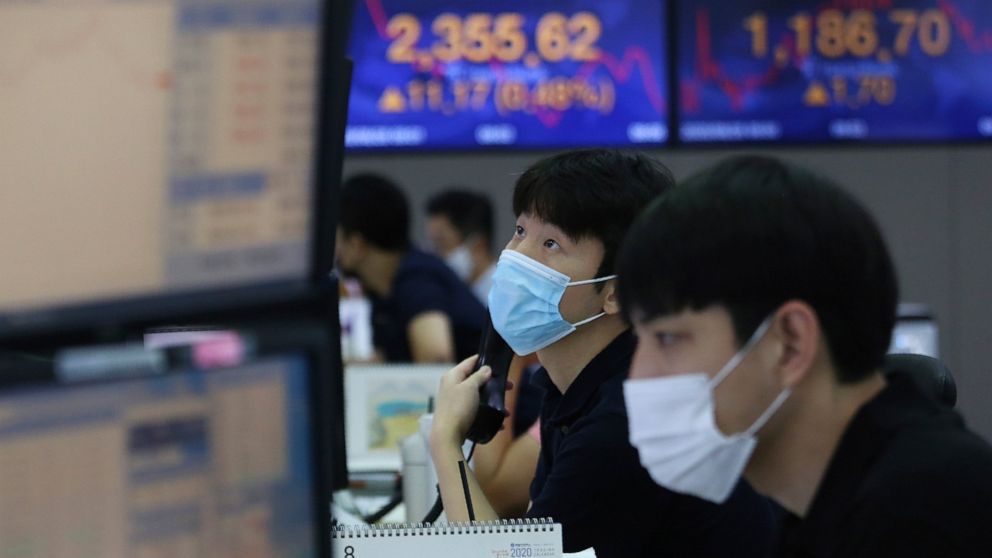S&P 500 rises, heading for year’s longest weekly win streak
Stocks keep ticking higher on Wall Street, and more gains for the S&P 500 Friday have it on pace to close out its fifth straight winning week
By
STAN CHOE and DAMIAN J. TROISE AP Business Writers
August 28, 2020, 5:30 PM
4 min read
NEW YORK — Stocks keep ticking higher on Wall Street, and more gains for the S&P 500 on Friday have it on pace to close out its fifth straight winning week.
The benchmark index was up 0.3% in afternoon trading, adding to its record. It’s up 2.9% for the week and on track for its longest weekly winning streak since December, before the coronavirus pandemic swept the world and sent economies tumbling into recession.
The Dow Jones Industrial Average was up 111 points, or 0.4%, at 28.603, as of 1:13 p.m. Eastern time. If it stays above 28,538.44, it would get back to even for 2020 and wipe out an earlier loss of as much as 34.9%. The Nasdaq composite was 0.2% higher.
A report released before trading began showed that U.S. consumer spending grew more in July than economists expected. That’s key because consumer spending is the main driver of the nation’s economy. Consumers increased their spending by 1.9% for the third straight month of gains, though it was a slowdown from June’s 6.2% growth.
Income also rose by 0.4% for Americans last month, snapping back from a drop in June.
Ulta Beauty, a company that relies on consumers opening their wallets, jumped 6.1% for one of the biggest gains in the S&P 500 after it reported a drop in profit for the latest quarter that wasn’t as bad as Wall Street analysts expected.
Technology stocks were also again helping to pull the market higher. HP rose 5.9% after it reported better profit for the latest quarter than analysts expected. The pandemic means more people are working and learning — and printing documents — from home, which helps sales of all kinds of products for HP.
Stocks are continuing to rise after the Federal Reserve on Thursday unveiled a change in strategy that likely means interest rates will stay low for a long time, even if inflation rises above the 2% target level of the central bank. It’s something Fed Chair Jerome Powell called “average inflation targeting” in a widely anticipated speech, and its full ramifications are still to be determined.
“Markets are trying to figure out what the Fed actually meant by its average inflation target,” said Jamie Cox, managing partner for Harris Financial Group.
Low interest rates and massive amounts of bond purchases by the Fed have helped prop up the economy, and they’re a central reason the S&P 500 has been able to recover from its nearly 34% plunge earlier this year, even though the pandemic is still raging.
With aid from the Federal Reserve firmly in place, investors want to see Congress also deliver more support for the economy. Weekly benefits that it approved earlier for unemployed workers have run out, and investors say the economy desperately needs another lifeline from Capitol Hill to carry it through its current weakness.
“You can already see some cracks forming in what consumer spending will look like if there isn’t much support in the future,” Cox said.
House Speaker Nancy Pelosi and the White House’s chief of staff resumed talks on a big aid package Thursday, the first attempt to restart talks after negotiations fell apart earlier this month. But no deal seems imminent with both sides remaining far apart.
Stock indexes abroad were mixed as the Fed’s momentous decision continued to work its way through currency and other markets.
In Europe, Germany’s DAX lost 0.5%, and France’s CAC 40 slipped 0.3%. The FTSE 100 in London was down 0.6%.
The Nikkei 225 lost 1.4% after Japanese Prime Minister Shinzo Abe said he is resigning due to health problems. Abe stepped down from a brief earlier term as prime minister in 2007, also for health reasons. He recently became Japan’s longest continuously serving prime minister.
Elsewhere in Asia, Hong Kong’s Hang Seng climbed 0.6%, South Korea’s Kospi added 0.4% and stocks in Shanghai jumped 1.6%.
The yield on the 10-year Treasury gave back a bit of its big rise from the day before, dipping to 0.73% from 0.74% late Thursday. The 30-year yield rose to 1.51% from 1.50%.
Longer-term yields remain well above shorter-term yields, including the two-year yield at 0.13%. A wider gap between them can indicate rising investor expectations for the economy and inflation in the future.
Benchmark U.S. crude oil slipped 0.1% to $42.98 per barrel. Brent crude, the international standard, rose 0.5% to $45.83.
———
AP Business Writer Elaine Kurtenbach contributed.
![]()


